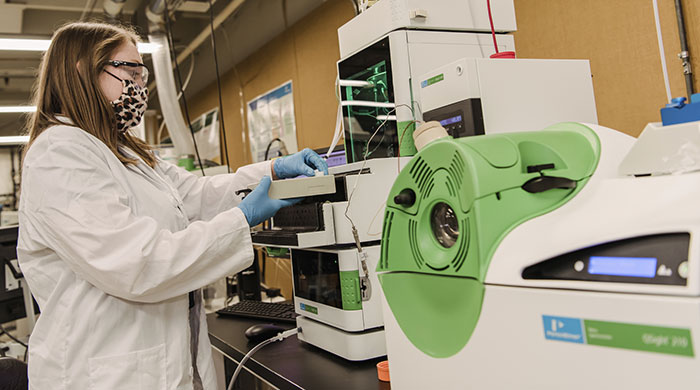Q&A: Environmental PFAS – the “Forever Chemical” and EPA Method 537.1
The presence of per- and polyfluoroalkyl substances (PFAS) in products used every day by millions of people is a growing cause of concern among both consumers and scientists. PFAS are considered “forever chemicals” and known to cause serious health issues in animals and humans. A deeper understanding of what they are and how they impact us is useful before detailing the methods used to detect environmental PFAS.
The Environmental Protection Agency (EPA) has deemed harmful per- and poly-fluoroalkyl substances an urgent public health and environmental issue. They can be found in surface water, groundwater, soil, and air—from the most remote rural areas to cities around the world.
A growing body of scientific evidence shows that exposure at certain levels to specific PFAS can adversely impact humans and the environment. Despite these concerns, PFAS are still used in a wide range of consumer products and industrial applications.1
We sat down with Amanda Belunis, a PhD candidate at the University of Maryland in Baltimore County to have her share her insights on improved methods used for the detection of PFAS. Her current research project focuses on method development liquid chromatography–tandem mass spectrometry (LC-MS/MS) to detect PFAS from a variety of environmental sources.
LCGC (Q): What are per and polyfluoroalkyl substances (PFAS) and how do they enter and contaminate consumer products?
AMANDA: Per and polyfluoroalkyl substances (PFAS) are a large family of manmade fluorinated chemicals that were developed in the 1940s. PFAS consist of a fully (per) or partially (poly) fluorinated chain connected to various functional groups. The compounds are hydrophobic, lipophilic, thermally stable, and generally inert and nonreactive, properties that are beneficial for a wide variety of applications including but not limited to non-stick cookware, food packaging, stain repellants, and aqueous film forming foam (AFFF) used by firefighters.
The main way PFAS can be present in consumer products is through direct means (for example, non-stick cookware and water-repellant clothing). PFAS can also contaminate consumer products such as drinking water through indirect means such as stormwater runoff or waste from nearby industrial facilities.
Q: You recently presented a technical poster that spotlighted an improved method validation and application for the detection of PFAS in drinking water sources following Environmental Protection Agency (EPA) 537.1 (1). How does this method differ from previous methods? What are its advantages?

Amanda Belunis working at UMBC’s LC-MS. Image from UMBC Magazine, August 9, 2021
AMANDA: This method provides further validation of EPA 537.1 on commercial instrumentation. I think one of the advantages this developed method offers is the various implementations made to reduce potential contamination. Additionally, along with collaborators at PerkinElmer, we were able to develop a higher throughput method by making changes to the liquid chromatography parameters, cutting down the run time from the recommended 37 min to 10 min.
Q: What challenges did you face in developing your method? How were they resolved?
AMANDA: PFAS are ubiquitous in the environment, including the laboratory, as these compounds are commonly used in many products including materials used for an SPE setup and LC-MS systems. In developing our method, we noted that there were several compounds present in blanks. The first step to resolving this issue was the installation of a secondary column between the pump and the autosampler, deemed the delay column. A delay column helps to remediate any PFAS that may be innately present in the eluents used for the HPLC pump, by delaying the elution of background PFAS.
Following the installation, background contamination was not completely resolved. This led to further steps being taken, including modifications to both the SPE apparatus and the autosampler to remove any polytetrafluoroethylene (PTFE) or PTFE copolymers. Contamination arising from the autosampler was remediated by switching PTFE tubing for polyetheretherketone (PEEK) material.
Through method development and troubleshooting, I have learned that one of the most important aspects of PFAS analysis is paying attention to minute details to reduce potential sources of contamination.
Q: How was high-pressure liquid chromatography (HPLC)–mass spectrometry (MS) analysis used in the detection of PFAS in drinking water?
AMANDA: LC-MS is the most commonly used analytical instrumentation for the detection of PFAS in aqueous environments. Liquid chromatography is best suited for the aqueous samples and allows for separation of the various PFAS of interest.
The mass spectrometry setup specifically used for this analysis was a tandem setup, known as a triple quadrupole, which consists of two quadrupoles in series with a collision cell in between. This detector setup allows for filtering of specific mass transitions for each analyte (precursor/product ion), adding an extra layer of selectivity to the method.
Q: Were techniques other than LC-MS used to detect PFAS in drinking water? If so, please describe what they were and how they differ from LC-MS.
AMANDA: While LC-MS is a very sensitive detection method on its own, however, there is still a need for sample preconcentration to detect the levels present in the environment. For this method, LC-MS was coupled with solid phase extraction (SPE). The PFAS present in a sample are retained on a solid sorbent and reconstituted in a smaller volume, allowing for preconcentration. With this method, roughly 250 mL of a sample is collected and resuspended in 1 mL after extraction, creating a 250:1-fold preconcentration.
Q: How does EPA method 537.1 change the process by which PFAS are detected?
AMANDA: There are several other approaches to analyze PFAS, some examples being combustion ion chromatography for total organic fluorine analysis and gas chromatography–mass spectrometry (GC–MS). However, in recent years the use of LC-MS for PFAS detection has been the main analytical instrumentation used in the field. EPA 537.1 differs in that it is a validated method for the detection of PFAS specifically in drinking water.
Q: Apart from the detection of PFAS in drinking water, are there other instances in which EPA 537.1 can be used to detect PFAS?
AMANDA: The EPA developed 537.1 solely for the detection of PFAS in drinking water, which is one of the major focuses right now in the field. Ideas from 537.1 could be taken and applied for the detection of PFAS in other aqueous environmental sources. There are other validated methods that the EPA is working on to detect PFAS in different sources. One such example is draft method 1633 published in August 2021 for the detection of PFAS in aqueous, solid, biosolids, and tissue samples by LC-MS.
Q: What are your next steps in PFAS contamination detection and method development?
AMANDA: LC-MS is a mature technology for the detection of PFAS. Moving forward, the focus will be on getting a better understanding of the full extent of the problem. Method 537.1 only covers detection of 18 selected PFAS, however, there are currently more than 5000 compounds in the group that have been identified. An additional focus in the future will be on improving method throughput.
Reference
- https://www.epAmanda:gov/system/files/documents/2021-10/pfas-roadmap_final-508.pdf
- Belunis, and W.R. LaCourse, “EPA 537.1 Method Validation for the Detection of Per- and Polyfluoroalkyl Substances (PFAS) in Drinking Water Sources,” University of Maryland, (2021).
Amanda Belunis is a PhD candidate in the department of Chemistry and Biochemistry at the University of Maryland, Baltimore County (UMBC). She has a Bachelor of Science degree in Forensic Chemistry from Towson University. Her experience includes working with instrumentation, sample preparation techniques, and method development for a wide range of applications.

